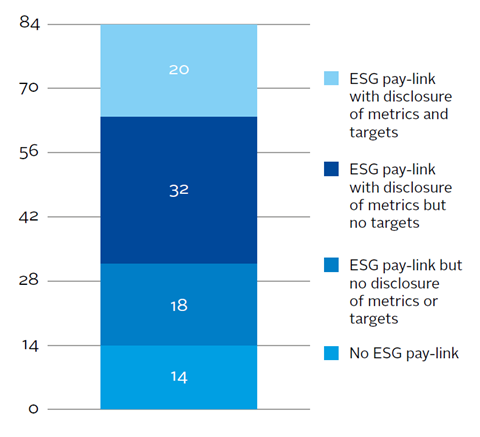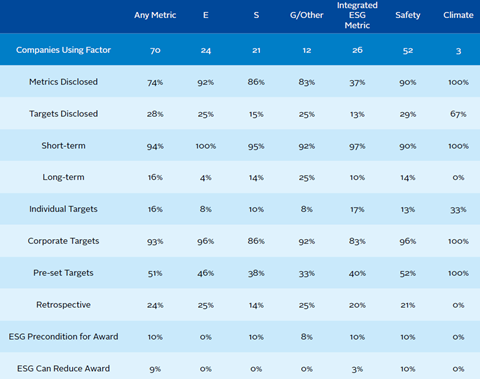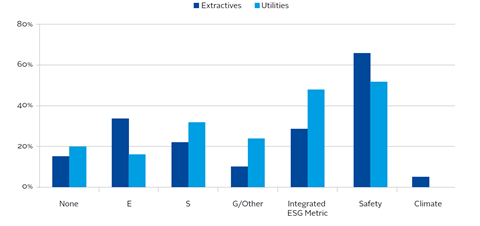The research analysis below summarises the practices of 84 extractive and utility companies included in major stock indices in North America, Europe, and Australia.
The research captured fifteen indicators related to ESG and pay practices for each company:
- Does the company link ESG issues to executive pay?
- What are the specific ESG factors referenced by the company?
- Are specific performance metrics defined relative to each factor?
- Are specific targets disclosed relative to disclosed performance metrics?
- Does the company incorporate ESG issues into shortterm incentives?
- Does the company incorporate ESG issues into longterm incentives?
- What is the proportion of the incentive determined by ESG metrics?
- Is performance measured against targets pre-set at the beginning of the performance cycle to determine incentive pay-outs?
- Is performance considered retrospectively to determine incentive pay-outs?
- Are ESG factors incorporated into the measurement of performance relative to individual objectives?
- Are ESG factors incorporated into the measurement of performance relative to corporate objectives?
- Are ESG factors a precondition for a portion of the incentive award?
- Can ESG factors reduce awards otherwise earned?
- Overall, does the remuneration committee have discretion in determining pay-outs?
- Overall, can awards earned for performance in one period be clawed back in later periods due to restatements of performance metrics or other factors?
Every ESG-related performance factor mentioned by each company was captured and categorised into six groups: under four broad headings of Environmental, Social, Governance and Integrated Metrics (where ESG factors across multiple categories are tied together into one metric, usually a scorecard); and two more specific headings, Safety and Climate Change, given their particular pertinence for companies in the utility and extractive sectors.
The in-depth analysis of public filings for 84 companies revealed that:
- 83% of companies incorporated some type of ESG issue into compensation decisions
- Among companies that integrated ESG factor into pay, 74% disclosed specific performance metrics by which ESG performance is measured.
- Despite the prevalence of disclosure on metrics, just 28% disclose a specific performance target.
Of the 70 companies that incorporated ESG issues into executive pay plans:
- 84% incorporated ESG factors into short-term compensation plans, rather than long term incentives.
- 41% of the companies that incorporate ESG factors into short term executive plans do not disclose their weighting e.g. the specific proportion of the award that is based on meeting ESG targets. When weighting was disclosed, ESG factors typically affected about 10% of the compensation package.
- 51% of companies measure performance against pre-set ESG targets, in order to determine pay-outs, while a quarter of the sample looks at performance retrospectively.
- 93% of companies measure ESG performance at the corporate level, but just 16% of extractive companies and 15% of utility companies also incorporate them into the measurement of individual performance.
- 20% of utility companies and only 6% of extractive companies use ESG factors as a precondition for awards.
- 15% of utility companies’ awards and 6% of extractive companies’ awards that are otherwise earned can be reduced based on ESG factors.
- 24% of companies allow for board discretion in determining remuneration awards, and 37% have clawback provisions.
- However, in both cases, companies did not provide detailed information on how discretion would be applied or how it related specifically to ESG factors, or on how clawback provisions would be implemented and whether they might by triggered by anything other than misleading financial statements.
For the 70 companies across the two sectors that incorporate ESG factors, figure 2 summarises how they are integrated into pay, and which issues are most frequently employed. Analysis of the data in figure 2 reveals the following patterns on metrics:
- Specific ESG performance metrics are disclosed in the vast majority of cases (92% for E, 86% for S and 83% for G/other), except for integrated ESG metrics, highlighting a lack of disclosure where integrated metrics are used.
- Environmental and safety metrics are each disclosed 90% or more of the time, possibly because these are seemingly more commonly quantifiable measures, and which are disclosed in other areas corporate reporting.
- Governance metrics are included at least 25% of the time in long-term awards, the highest percentage by far.
Sector analysis
The table below details the frequency with which each factor was used by extractive and utility companies. These percentages are based on 59 extractive and 25 utility companies. Analysis of the data in Figure 3 reveals the following patterns on ESG topics by sector:
Utilities
The research indicates that 80% of the sample incorporated some ESG link in pay decisions. Of these companies, 65% disclosed metrics and 35% disclosed specific quantitative targets alongside them.
Safety is a key issue for the industry, therefore it is not surprising to see it featuring heavily in the data. While safety has a potential impact on physical, regulatory and reputational risk, this raises the question of whether there is an excessive focus on one key issue, as no other ESG factor was employed by more than half of companies reviewed. Social factors (excluding safety) are the second most integrated at 32%, but this does not seem adequate given the wide variety of social issues that could impact company performance, such as employee engagement and retention.
Governance and environmental metrics weigh heavily in the list of key ESG issues reported by companies; however, 24% of utility companies actually link governance-related metrics into executive pay and 16% integrate environmental factors. That 48% of utility companies use integrated metrics could explain this apparent mismatch as integrated metrics predominantly include health and safety and environmental issues.
No utility companies in the sample incorporated climate change metrics such as carbon emissions into executive pay, despite their own sustainability reporting as well as industry analysts and research experts referring to climaterelated issues as a material risk.
Outliers or emerging best practice?
A few companies’ programmes stood out as having more sophisticated designs, for example, incorporating specific ESG hurdles before bonuses can be earned under other performance metrics. At the Australian utility SP Ausnet, long-term incentives cannot be earned when fatalities occur, and at the German utility RWE, ESG reporting and employee satisfaction metrics serve as the basis for a bonus-malus that can reduce awards earned in other ways.
Extractives
The inclusion of ESG metrics in executive pay has become very common in extractive industries: 85% of the extractive companies in the sample linked pay to ESG issues and 78% of those disclosed the use of at least one ESG metric in determining executive pay. However, many extractive companies employed these metrics primarily as a qualitative factor in determining compensation and disclosed neither quantitative performance metrics nor specific targets against which performance was measured. Just 26% of the companies disclosed specific targets in determining compensation amounts.
As with utility companies, safety was the most commonly used ESG issue in pay, employed by 65% of extractive companies. This was followed by environmental issues at 33% and social issues at 22%, with only 10% of companies referencing governance issues.
Extractive companies better aligned the key ESG issues referenced by companies and industry experts with the ESG issues linked to pay. Safety is still a very important factor (66%) but the gap between it and environmental issues (34%) was narrower, and a further 29% use integrated metrics, which predominantly include health and safety and environmental issues.
However, despite the importance of social issues for the sector, and even for a company’s ability to carry out its operations (license to operate and political instability are crucial, especially in the regions where mining and drilling are often carried out), only 22% of the sample considered social factors when setting pay structures.
Climate change metrics such as carbon emissions are a significant concern for oil and gas companies but only three incorporated emissions-related metrics into performance pay.
Utilities disclose fewer metrics, but those that do also include targets
While the proportion of utility companies disclosing metrics was 13 percentage points less than at extractive companies, the proportion of companies disclosing targets was 9 percentage points higher than the extractive companies sample.
Download the full report
-

Integrating ESG issues into executive pay
2016
How to integrate ESG issues into executive pay: a review of utilities and extractives
- 1
- 2
- 3
- 4
 Currently reading
Currently readingSector-specific data
- 5
















